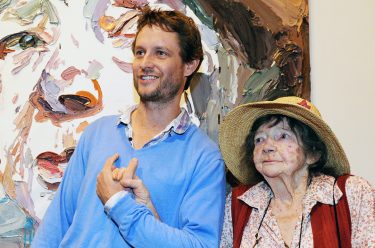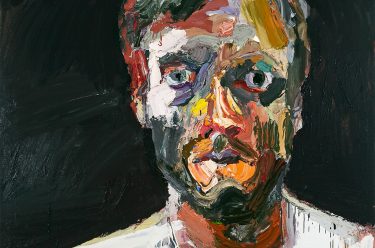We spoke with Ben Quilty and his two children, Joe and Olivia, about inspiring young people to begin their own art practice and to continue making art forever. During school holidays, Quilty loves having his children around the studio. ‘I like them to be in there with me’, he says. ‘We make paintings together, and inevitably I make paintings about them. Sometimes they are really annoying and sometimes they’re really lovely; sometimes they give me kisses and sometimes they yell at me. I like to make paintings about the kissing and the yelling.’1

Quilty’s studio, in the Southern Highlands of New South Wales, is a large and inviting warehouse space with a paint-splattered concrete floor. Completed canvases line the walls, and his palette, a large trolley table he’s been using for 20 years, is caked with layers and freshly squeezed oil paint in a rainbow of colours. He wears old boots and overalls when painting, and it is the ordinary quality of his materials that he hopes will inspire children to begin making art.
‘The objects and materials that I use to make paintings aren’t special. They’re just paint and an old table with wheels on it, and I think it’s really important that kids see what my materials and objects are that enable me to make paintings’, Quilty says. ‘I think every house should have a big palette in it somewhere for children to paint and make drawings and continue their own art practice.’
Watch our time-lapse of Joe Quilty painting Ben
When Joe painted his father’s portrait, he began by outlining the face and marking out the placement of the features, ‘A portrait should not only capture someone’s physical likeness but also express who they are and what they feel’ using lines to map the structure of the body and its relationship to the surrounding environment. The colour, shape and style of each line expresses his ideas about the subject. Quilty has painted many portraits of Joe since he was a baby, often working from photographs when Joe was too young to maintain a pose. Both father and son agree that the experience is most meaningful when you can sit down with a person and talk to them — a portrait should not only capture someone’s physical likeness but also express who they are and what they feel.
In creating his self-portraits, Quilty sometimes works from photographs when he is trying to achieve a particular pose, but more often he studies his face in the mirror and spends a long time looking at his reflection. ‘I started to think, “How weird am I?” . . . human beings are really weird’, he says. This feeling of weirdness has inspired a series of playful self-portraits that exaggerate key features of his face, such as using a sausage from his local butcher as a model for a long, winding nose. As part of the project ‘Family Portrait’, Qulty also encourages children to experiment with colour and abstraction to create a digital portrait they can share with friends and family.
Explore portraiture with Ben Quilty
It is when talking about why Quilty thinks it is important for children to be involved in art from a young age that he is most visibly passionate about his own practice inspiring others to find lifelong joy in creating art. ‘All children draw’, he says, ‘but it seems that when you get to about 12 or 14 or 16 there is this expectation that you will stop. I reckon you should keep drawing forever. If all the adults drew, they would be much, much cooler . . . So I hope that children walk away from the Gallery being inspired to keep making.’
Laura Mudge is Senior Program Officer, Children’s Art Centre, QAGOMA
Endnote
1 All quotes are from interviews with the artist and his children, 22 January 2019.
The importance of drawing
Featured image detail: Ben Quilty in his studio with Joe / Photograph: Jeremy Virag
‘Ben Quilty: Family Portrait’ was at the Children’s Art Centre, Gallery of Modern Art, from 15 June until 20 October 2019. ‘Quilty’ was on from 29 June until 13 October 2019.
#QAGOMA


